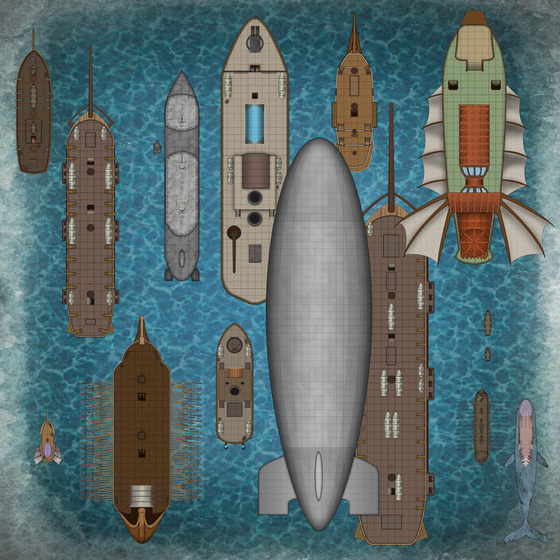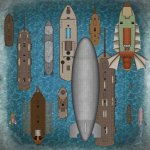You may recall that earlier this year EN Publishing ran a successful Kickstarter for Admiral o' the High Seas, a supplement with easy-play rules for naval combat and high seas adventure. Compatible with Pathfinder, 4th Edition, and more. We've been working hard on the book, and here's an update on where we're at.
I've got an excerpt today from the non-combat side of things, covering guidelines for handling long voyages. It's a bit topical, I feel, because due to a bit of my own misnavigation (and a rather great idea for another port to visit), we're sadly missing our initial targets of releasing the pdf in July and the print book in August. But I will be handing off the text to layout within a week, along with the more varied maps that we're adding in.
Per some suggestions in response to our last post, in addition to the pieces in the main book which will be primary examples of a variety of ships, we'll also be including a layered PDF of the ships so you can toggle features you want or don't want, see different decks, or even swap out cannons for eldritch fusils.
Navigation
A ship’s listed speed is its usual top speed in knots in normal conditions. With favorable winds, calm seas, or magical aid, ships can briefly go faster, while choppy seas or poor winds can dramatically slow a ship down. For the sake of determining travel time, though, multiply a ship’s speed rating by 10. That’s the number of miles it can reliably travel in a day.
Yes, it’s about 35% of what the ship could accomplish at full speed. That improves with an able navigator at the wheel, and truly excellent conditions can double a ship’s daily speed.
There are three steps to navigating for a voyage: Determine Hazards, Plot a Course, and Follow the Course.
Determine Hazards
First, the navigator must anticipate hazards like bad weather, shoals, cursed currents, and sharktopus breeding grounds. Any number of characters can make a Nature check to predict when the ship is likely to run afoul of bad seas, weather, and other natural hazards; and a History check to recall more active threats in the area, like pirates and sea monsters. These checks are generally DC 10 in safe seas, but might be higher in areas with more densely arrayed dangers, or where dangers are less well known.
[[In Pathfinder, make Knowledge (nature) or Survival checks for the first, and Knowledge (history) checks for the second. Alternately, make Profession (sailor) checks.]]
A success ensures the navigator is informed of possible dangers. A failure means the navigator might unwittingly guide the ship into peril.
Plot a Course
Next, the navigator must plot a course. This requires an Intelligence check, which only a single character can make. No more than two allies can Aid Another for his attempt.
The check is DC 0 if the route hugs a coast, DC 5 if the ship leaves sight of land but never for more than a day at a time, and DC 10 if the ship goes out of sight of land for more than a day. Poor charts might increase the DC by 5, while sailing an uncharted sea increases the DC by 10.
[[In Pathfinder, make a Knowledge (geography) check, and increase the DCs by 5. Alternately, make a Profession (sailor) check.]]
Special circumstances might increase the DC by 2 or 5, such as if the navigator is trying to avoid an expected storm, if the captain wants to take the ship on an unusual route to avoid pursuit, or if the ship needs to hit multiple specific ports, or if the navigator is trying to hit a moving target that he has a schedule for, like an island on the back of a turtle with a regular migratory pattern, or a heavily-laden treasure ship delivering a tithe to a church.
A success means the course is accurate and will get the ship where it wants to go, barring unforeseen circumstances. A check that succeeds by 5 or more makes good use of currents and winds, which decreases the duration of the trip by 20% (from 17 days to 14 days, for instance).
A failed check sets the ship on the wrong course. Even if the navigator is using a sextant or magic to know his location perfectly, that doesn’t help if he thinks the destination is in a different spot than where it actually lies. Unless the ship happens across some sort of landmark that shouldn’t be on the route the navigator erroneously plotted, the ship will keep sailing, perhaps end up hundreds of miles off course.
Follow the Course
Finally, the ship actually has to follow the course. The navigator makes a Wisdom check (DC 10). As with plotting the course, up to two allies can Aid Another for this check.
[[In Pathfinder, the navigator makes a Survival check (DC 15). Alternately, make a Profession (sailor) check.]]
If the navigator succeeds, the ship arrives on time and avoids all the hazards the navigator was aware of when he plotted his course, though the ship might encounter hazards he did not know to avoid. A failure means the ship drifts off course, which might lead into a hazard, and in any event increases the journey’s time by 10%. The navigator must then make another check, and further failures keep increasing the journey’s duration by 10%.
Meanwhile, the captain or one of his officers makes a Command check (DC 15) to keep the crew in order. If the ship has a crack crew, the captain gets a +5 bonus to his checks. If the ship has less than full crew but at least minimum crew, instead he takes a -5 penalty. A skeleton crew imposes a -10 penalty.
If the captain succeeds, the ship travels at its average speed. For every point he beats the DC by, decrease the trip’s duration by 1%. If he fails, increase the trip’s duration by 1% for every point he failed the DC.
Finally, here's a look at the whole family.

Per some suggestions in response to our last post, in addition to the pieces in the main book which will be primary examples of a variety of ships, we'll also be including a layered PDF of the ships so you can toggle features you want or don't want, see different decks, or even swap out cannons for eldritch fusils.
Navigation
A ship’s listed speed is its usual top speed in knots in normal conditions. With favorable winds, calm seas, or magical aid, ships can briefly go faster, while choppy seas or poor winds can dramatically slow a ship down. For the sake of determining travel time, though, multiply a ship’s speed rating by 10. That’s the number of miles it can reliably travel in a day.
Yes, it’s about 35% of what the ship could accomplish at full speed. That improves with an able navigator at the wheel, and truly excellent conditions can double a ship’s daily speed.
There are three steps to navigating for a voyage: Determine Hazards, Plot a Course, and Follow the Course.
Determine Hazards
First, the navigator must anticipate hazards like bad weather, shoals, cursed currents, and sharktopus breeding grounds. Any number of characters can make a Nature check to predict when the ship is likely to run afoul of bad seas, weather, and other natural hazards; and a History check to recall more active threats in the area, like pirates and sea monsters. These checks are generally DC 10 in safe seas, but might be higher in areas with more densely arrayed dangers, or where dangers are less well known.
[[In Pathfinder, make Knowledge (nature) or Survival checks for the first, and Knowledge (history) checks for the second. Alternately, make Profession (sailor) checks.]]
A success ensures the navigator is informed of possible dangers. A failure means the navigator might unwittingly guide the ship into peril.
Plot a Course
Next, the navigator must plot a course. This requires an Intelligence check, which only a single character can make. No more than two allies can Aid Another for his attempt.
The check is DC 0 if the route hugs a coast, DC 5 if the ship leaves sight of land but never for more than a day at a time, and DC 10 if the ship goes out of sight of land for more than a day. Poor charts might increase the DC by 5, while sailing an uncharted sea increases the DC by 10.
[[In Pathfinder, make a Knowledge (geography) check, and increase the DCs by 5. Alternately, make a Profession (sailor) check.]]
Special circumstances might increase the DC by 2 or 5, such as if the navigator is trying to avoid an expected storm, if the captain wants to take the ship on an unusual route to avoid pursuit, or if the ship needs to hit multiple specific ports, or if the navigator is trying to hit a moving target that he has a schedule for, like an island on the back of a turtle with a regular migratory pattern, or a heavily-laden treasure ship delivering a tithe to a church.
A success means the course is accurate and will get the ship where it wants to go, barring unforeseen circumstances. A check that succeeds by 5 or more makes good use of currents and winds, which decreases the duration of the trip by 20% (from 17 days to 14 days, for instance).
A failed check sets the ship on the wrong course. Even if the navigator is using a sextant or magic to know his location perfectly, that doesn’t help if he thinks the destination is in a different spot than where it actually lies. Unless the ship happens across some sort of landmark that shouldn’t be on the route the navigator erroneously plotted, the ship will keep sailing, perhaps end up hundreds of miles off course.
Follow the Course
Finally, the ship actually has to follow the course. The navigator makes a Wisdom check (DC 10). As with plotting the course, up to two allies can Aid Another for this check.
[[In Pathfinder, the navigator makes a Survival check (DC 15). Alternately, make a Profession (sailor) check.]]
If the navigator succeeds, the ship arrives on time and avoids all the hazards the navigator was aware of when he plotted his course, though the ship might encounter hazards he did not know to avoid. A failure means the ship drifts off course, which might lead into a hazard, and in any event increases the journey’s time by 10%. The navigator must then make another check, and further failures keep increasing the journey’s duration by 10%.
Meanwhile, the captain or one of his officers makes a Command check (DC 15) to keep the crew in order. If the ship has a crack crew, the captain gets a +5 bonus to his checks. If the ship has less than full crew but at least minimum crew, instead he takes a -5 penalty. A skeleton crew imposes a -10 penalty.
If the captain succeeds, the ship travels at its average speed. For every point he beats the DC by, decrease the trip’s duration by 1%. If he fails, increase the trip’s duration by 1% for every point he failed the DC.
Finally, here's a look at the whole family.

Attachments
Last edited:











